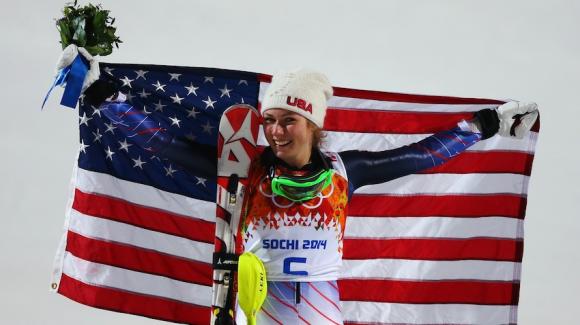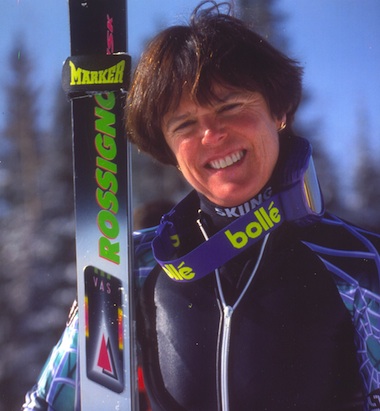Widgetized Section
Go to Admin » Appearance » Widgets » and move Gabfire Widget: Social into that MastheadOverlay zone
America’s first World Cup winner Cutter quit young for college, but Shiffrin to study and ski
Ski racing's top young star studies for SAT tests while gearing up for next season
April 14, 2014, 7:10 am

Eagle-Vail’s Mikaela Shiffrin, 18, became the youngest woman to ever win Olympic slalom gold in February (Getty Images/Alexander Hassenstein).
In February of 1968, when she was younger than Mikaela Shiffrin is now, Kiki Cutter became the first American ski racer to win a World Cup event.
Just two years later, after the 1970 World Alpine Ski Championships at Val Gardena, Italy, Cutter retired at the age of 20 with five World Cup victories – the most wins by an American for nearly a decade.
“I did [retire] very young,” said Cutter, a member of Colorado Ski and Snowboard Museum Hall of Fame. “But I wanted to continue my education and I couldn’t very well do that while I was racing. My family was not a wealthy family, and it was an expensive sport. I didn’t see a future in ski racing.”
Shiffrin, on the other hand, recently turned 19 after an incredible two-year run that’s included an Olympic slalom gold medal, a slalom world championship and nine World Cup victories. The sport’s new superstar, who calls Eagle-Vail home, plans to keep training for next season while studying for the SAT tests and eventually taking college courses.
Shiffrin said she’s seriously considered doing what Cutter did – quitting racing to pursue her education.
“No, it’s not crazy talk at all. I’ve definitely thought about that, but each time I think about it I’m like, ‘Nope, I’m not done yet,’” said Shiffrin, speaking on a call coordinated by pasta sponsor Barilla, promoting its new “Share the Table” family dining campaign. It would be too hard to take significant time off for college and come back at the same competitive level, Shiffrin added.
“I have quite a few more things I want to accomplish in ski racing. I know there’s more I want to do and more I can make of the sport, too – not just for myself but for the rest of the world,” Shiffrin said. “I want to get ski racing out there and I want to make it to the next Olympics and see how many medals I can win there if I can win any.”
Shiffrin, unlike Cutter, has the option to do both because of the way the sport has changed so much in 40-plus years. Strict amateur rules prevented racers from taking sponsorship cash in the late 60s and early 70s – one of the reasons Cutter’s ex-husband, U.S. Ski Team founder Bob Beattie, split away from the World Cup circuit he helped establish in 1966 and launched a men’s pro tour.
“We were not making anything [on the World Cup circuit],” Cutter said. “If we had been making the money – not even that they’re making now – but even 10 years ago, I probably would have stayed on. I had a great future in ski racing.”
Married to Beattie from 1968 to 73, Cutter raced for a few years on the women’s pro circuit but admits “there wasn’t a lot of money in women’s pro racing, although it was a ton of fun.” Now 64 and living in New Hampshire after three decades in Aspen and another 10 years in her hometown of Bend, Ore., Cutter would have liked a few more years on the World Cup circuit.
“It’s not a sense of regret, but it would have been lovely if I could have continued,” she said. “Deep down I would have liked to have continued racing.”
Cutter went on to great success in the ski industry, working with Rossignol and establishing both a celebrity ski fundraising event and a youth scholarship program in Aspen, but it’s clear the competitive juices were still flowing when she retired in 1970. She said at the time the Europeans enjoyed a huge advantage compared to today.
“Over there skiing’s a national sport and they’re heroes,” she said. “They’re like our greatest football stars or basketball stars or baseball stars and they were subsidized by their countries. It’s amazing that we even did as well as we did against the Europeans.”
That funding disadvantage and competing pro tours eventually led to changes in amateur sponsorship rules. Now professional skiers compete in the Olympics, and ski racing’s top stars like Vail’s Lindsey Vonn, are multi-millionaires.
Those changes have allowed athletes like Bode Miller to contemplate sticking around for another Olympic run in 2018 (for what would be his sixth Games) after just becoming the oldest man to win an Olympic medal in Sochi. In that way, many current World Cup records have to be viewed through the prism of longevity owing to financial security.
Vonn, 29, didn’t win her first World Cup race until she was 20, but now she’s claimed 59 and is just three behind Austrian Annemarie Moser-Proell’s all-time women’s mark of 62 career victories. Shiffrin has already won nine times and just turned 19.
“I’m a little bit torn because I don’t want to beat her records because she set them and people should know that forever, that Lindsey Vonn set these record in the U.S.,” Shiffrin said. “She was the first person to really show people what ski racing is, because it’s kind of a dying sport right now and she’s the one keeping it alive. I just hope to kind of run alongside her and her and help keep it going – to do my own part to keep this sport alive and inspire other athletes.”
Cutter thinks Shiffrin can do anything she sets her mind to.
“She is mature beyond her years, and I think her parents have done a great job with her,” Cutter said. “She races for herself. She loves it, and with that attitude she will continue to dominate. I don’t know if the pressure will ever get to her because she thoroughly enjoys what she does.”
This story was produced for the Colorado Ski & Snowboard Museum and a version first ran in the Vail Daily. The museum is located on the third level of the Vail Village parking structure, adjacent to Vail Village Covered Bridge. It is open daily from 10 a.m. to 6 p.m. For more information, call 970-476-1876 or go to www.skimuseum.net.
David O. Williams
Latest posts by David O. Williams (see all)
- Neguse, Bennet call for halt to BLM emergency rule aimed at increasing Utah oil-train traffic - June 23, 2025
- The O. Zone: Trump’s long list of broken campaign promises just jumped to yet another forever war - June 23, 2025
- The O. Zone: Coming to Vail this summer? Leave fireworks, risky fire behavior at home - June 20, 2025
2 Responses to America’s first World Cup winner Cutter quit young for college, but Shiffrin to study and ski
Recent Posts
- 39th annual Salute to USA welcomes Lettuce followed by fireworks and more
- Vail Fourth of July festivities
- Berry Creek Bash is back
- Pamela Goldsten honored as recipient of Vail Health Elevate Award
- Opinion: When daily violent prayer morphs into homegrown Christian terrorism
- Commissioners seeks input on public lands in Eagle County
- Eagle County to break ground on phase 1 of final segment of Eagle Valley Trail
- Ace Hardware set to open store in Avon
- Vail Hill Climb set for Saturday, July 5
- Summer of laughs at Vilar Performing Arts Center




Michael Beckley
April 14, 2014 at 12:06 pm
I think she’s an incredible athlete and way mature beyond her years. I worry, however, that skiing is really dying. I know #’s can be made to say anything but what doesn’t lie is the fact that the sport has existed on Real Estate revenues for so long. Operating dollars require skiers and boarders. Young people are in such debt from student loans and lack of jobs that dropping a couple of grand to buy or rent skis and go somewhere to ski is just way low on their priorities. Throw into that mix the absurdity of the I-70 situation and it’s a Colorado disaster story. It’s sad because it is an amazing experience….sliding down a mountain on a blue Colorado day. Somewhere it just all went terribly wrong. Perhaps it was the $20.00 hamburger?
David O. Williams
April 22, 2014 at 2:44 pm
Well said, Mike. Things have changed dramatically since I was a kid learning to ski on the icy slopes of Blue Knob, Pa. The number of Americans skiing hasn’t grown appreciably since then but the slopes seem more crowded and stressful at times, maybe because there hasn’t been a major new resort since Beaver Creek in 1981. Very insightful of someone as young as Mikaela to recognize there’s a problem and to want to be part of the solution. Rare for 19-year-olds to think that deeply.